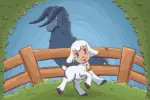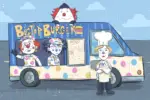The TV show “Bluey” has become massively popular, but it’s not the kids who seem to be watching it, it’s the adults. TikTok users have been watching bits and pieces of the show as they come across it on their For You Pages, and people have fallen in love with it. “Bluey” is an ongoing animated show produced in Australia that allows adults to reminisce about their childhood while also relating to some of the more mature characters and themes. But there’s more to this show than meets the eye, as it breaks away from the traditional kids show format that people may be familiar with. While the show is designed to teach children important lessons, it also re-educates adults on some of life’s forgotten morals.
“Bluey” takes place in Australia where each and every character within the universe is a type of dog; they each have their own personalities, as well as struggles that children and adults can easily relate to. The show mainly focuses on the Heelers, a family of four who encounter a variety of challenges, big and small, while living their day-to-day life. As the title of the show would suggest, the narrative usually follows Bluey — the oldest sister.
Bluey is a rather imaginative puppy, and loves playing games with her friends, family and youngest sister, Bingo. Yet the young pup encounters plenty of obstacles, many of which seem small to the adults, but huge to her. As she figures out how to overcome these challenges, sometimes her parents, Bandit and Chilli, will either tell her the correct solution or push her in the right direction. While most of the episodes focus on the Heeler’s, there are stray episodes that follow Bluey’s friends and other family members. Some of the problems and questions the show “Bluey” addresses are far more complicated, and can easily go over a child’s head but remain embedded within the minds of adults.
One example is the episode titled “Onesies” in season 3 where Chilli’s sister, Brandy, finally gets in touch with her sister and visits her nieces. The reason for this? Brandy, as the adults are made aware of, is incapable of having children, a reality which can be extremely heartbreaking for parents to discover. While the gravity of this discovery can be easily missed by the minds of children, it becomes abundantly clear to adults when Chilli explains to Bluey that Brandy “wants more than anything as well but she can’t have it.” It’s a chilling realization that can easily strike a chord with adults who may struggle with similarly emotionally taxing issues.
It seems rather obvious why adults fall head over heels in love with this children’s show, as it addresses adult-like problems and mental health concerns. These specific issues will go unnoticed by a young child, yet feel clear to adults and possibly new parents. “Bluey” allows new parents to feel a sense of relief at how realistic the show feels when discussing the mental health challenges adults may face later on in life. It also makes new parents feel comforted that not everything at home needs to be perfect; the house can be a mess, the kids don’t always go to bed on time and being a parent can be exhausting. The show allows adults to take a simple breather, knowing that things will work out eventually, whether in the long-term or short-term.
One problem that every new parent deals with is the level of competition between parents regarding their firstborn children. The episode titled “Baby Race” in season two shows Chilli feeling doubtful about being a new mother due to their neighbor’s baby, Judo, progressing much faster than everyone else. Baby milestones are rather important for new parents, but can be ruined when they feel like their children must compete with other babies around the same age. The episode depicts that Chilli feels inadequate as a mother, like she is failing compared to the other mothers as their children start walking while Bluey is still crawling. Eventually, another mom stops by and tells the new mom that she’s doing great, regardless of how Chilli may truly feel. It’s an emotional episode that can bring tears to anyone’s eyes, as an adult dog tells another adult dog that they’re doing great, something many people need to hear on occasion.
In season two, in an episode called “Army,” Bluey meets a new friend named Jack, who recently transferred because he had a hard time staying still and focusing on tasks directly in front of him. This context clue points to Jack having Attention Deficit Hyperactivity Disorder, or ADHD, as the Jack Russell Terrier admits he isn’t sure why he can’t focus or remain still. It’s clear to adults why Jack can’t focus and keep still, and while the details remain a bit fuzzy for children, Jack’s situation is relatable to kids who may be undiagnosed but have ADHD. Even though this episode of “Bluey” isn’t as emotional as others, it still conveys that kids at a young age can already exhibit signs of a learning disability, and it emphasizes the importance of understanding and accepting that everyone learns a bit differently.
This children’s tv show stands out among its competitors since it does not follow the classic teaching method everyone is familiar with. Most children’s shows designed for preschoolers take on an interactive call-and-response style where the show expects the child to answer each question thrown their way. “Bluey” breaks this stereotype since it does not follow this classic formula but instead gives the answers in an indirect way. The show’s storytelling is more realistic, it emphasizes the fact that not all issues can be tied up in a neat 20-minute narrative bow. The show also features more realistic storytelling and simple animation. When Bluey and Bingo play pretend, the animators never animate them in said pretend world but instead keep them in the current setting as their parents talk in the background. This can resonate with adults who remember playing these imaginative kinds of games in their childhood homes as their parents focused on something else.
There are so many lessons both children and adults can learn from the show “Bluey” that remain important through every stage in life. Even though the show is produced in Australia, and the characters sport accents, many people have found themselves flocking to Disney+ in order to get a taste of the show. While each episode of “Bluey” runs for only ten minutes, adults find each episode compelling as they teach children lessons and spring confidence into adults. While you may feel silly watching this kids show in the beginning, your inner child will be overjoyed to be watching something as entertaining as “Bluey.”

















